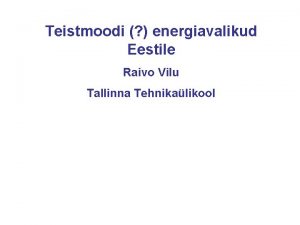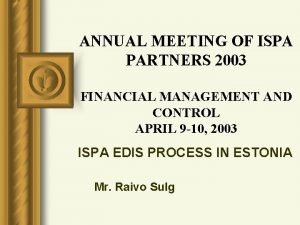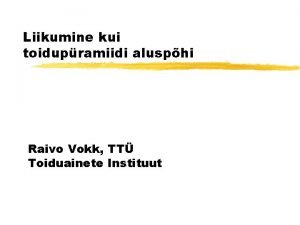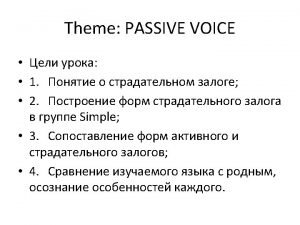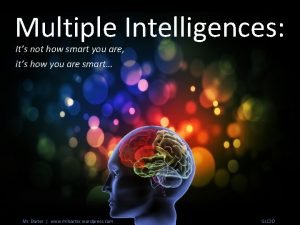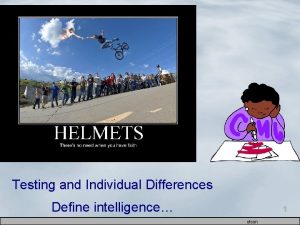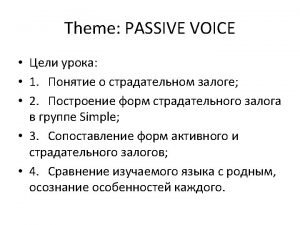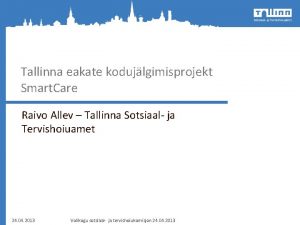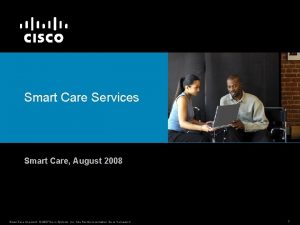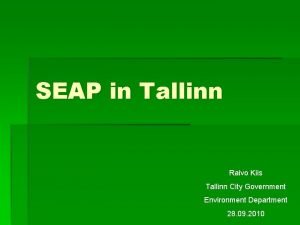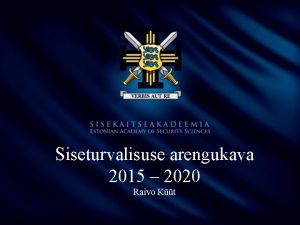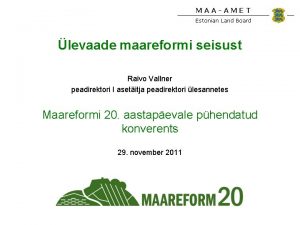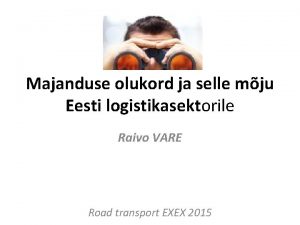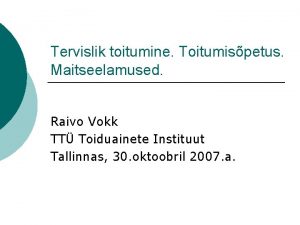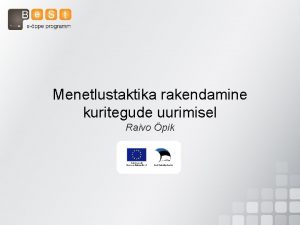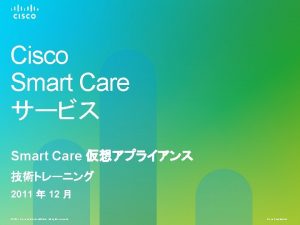Smart Care care in the future Raivo Allev






















- Slides: 22

Smart Care – care in the future Raivo Allev, Tallinn City Social Welfare and Health Care Board

Content Tallinn City Smart Sare project E-services in Tallinn 30. 05. 2013 UBC meeting in Tartu 1

City of Tallinn, the Capital of Estonia, is located in Northern Europe in the north-eastern part of the Baltic Sea region, on the coast of the Gulf of Finland Tallinn has 40 kм² of greenery areas (parks, forests etc) Population: 416 993 Area: 159, 1 km² Density: 2, 618 people per km² Islands: Aegna (3, 04 km²) Lakes: Harku Lake (1, 7 km²) Ülemiste Lake (9, 4 km²) Sea coast: 46 km Land boarder: 59 km 30. 05. 2013 UBC meeting in Tartu 2

City of Tallinn • 40 kм²(~35 %) of greenery areas (64 parks, forests etc) • 19 high education institutions • 15 theatres (project-based and repertoire) • 17 city libraries + a library bus • 18 concert halls • 52 museums • zoo • botanical garden • 141, 3 km bicycle paths • 16 ports and harbours • 940 km roads 30. 05. 2013 UBC meeting in Tartu 3

City District Administrations In order to better fulfill the functions of local government, the City of Tallinn is divided into 8 City Districts The District Administrations (Governments) are city institutions that fulfill, in the administrative territory of their city district, the functions assigned to them by Tallinn legislation and statutes Haabersti City District 30. 05. 2013 UBC meeting in Tartu 4

City Districts General Data POPULATION AREA km² EMPLOYEES in City District Administration 1. LASNAMÄE 116 151 27, 41 97 2. MUSTAMÄE 64 003 8, 15 57 3. NORTHEN-TALLINN 56 626 15, 16 86, 5 4. CENTRE incl Aegna island 3 km² 51 969 30, 62 71 5. NÕMME 38 990 29, 16 47 6. HAABERSTI incl Harku lake 1, 7 km² 42 464 22, 17 49 7. KRISTIINE 30 077 7, 87 47 8. PIRITA 16 713 18, 69 32, 5 416 993 159, 23 487 CITY DISTRICT and Ülemiste lake 9, 4 km² TOTAL 30. 05. 2013 UBC meeting in Tartu Population: http: //www. tallinn. ee/g 4258 s 9268, Employees 5

Background for European and Estonian population aging is rapid. Our workforce goes to Finland elsewhere in Europe, who take care foue us in futrure? • Robots? I do not want it, but I agree: • All that can be done by a machine, the machine must be allowed to do - people are more in comfortable and safe. • How started Smart. Care preparation? • 30. 05. 2013 UBC meeting in Tartu 6

Previous project: International telecare project 2008 -2012 A consortium of 13 partners, among others, East Tallinn Central Hospital Ambulatory telemonitoring of patients at home, 60 patients with chronic lung diseases, heart patients and diabetics. Monitoring equipment installed in homes, doctors and nurses watched and made appropriate decisions to change treatment 30. 05. 2013 UBC meeting in Tartu 7

Benefits of a DREAMING service More satisfied senior citizens Reduces isolation of elderly people Creates new communication possibilities between caregivers and patients Professional care according to the needs of the patient Better medical service availability Avoids unexpected situations • Ambulatory visits • Hospitalizations 8

Alarm Button – provided by Tallinn City The goal of this service is to call for help primarily in situations where the person is unable to move by him/herself and to open the door for the helpers, for example: Sudden need for medical help, with an immobilising effect; Sudden need for so-called personal help (falling, temporary inability to move, becoming trapped in inner rooms, etc. ); Situations necessitating rescue services (fire, explosion, etc. ). 9

Alarm Button II 30. 05. 2013 The service is used by clients suffering from serious illnesses, such as cardiovascular diseases, diabetes mellitus, hypertension, Parkinson's disease, asthma, stroke and / or heart attack. The health status of clients often occur due to imbalance, which can lead to falls. Help needed client challenges are the main causes of health problems (falls, heart rhythm disorders, shortness of breath, weakness, a temporary inability to move). If necessary, an ambulance is involved, which evaluates human health and, where appropriate, leads. UBC people to hospital. meeting in Tartu 10

Same patients/clients for SW and HC The aim for Smart. Care project: 30. 05. 2013 UBC meeting in Tartu 11

Generic socio-technical system example Care receiver / Smart. Care beneficiary Informal carers • Joint discharge planning • Joint home care plan management • Remote doctor visits • Medical alerts • Social alarms • Remote rehabilitation Integrated hospital discharge home support • Home health monitoring • Response to critical situations Health Care Provider (Hospita l) • Home safety monitoring • Emergency response Connecting Hub Social Care Provider Tele-health infrastructure Tele-care infrastructure Patient record system Social care record system Third-sector organisation • Joint planning of discharge process • Joint home care plan management • Shared client data access / updating Joint client data base

Smart. Care – partner states ant integrated service model 30. 05. 2013 UBC meeting in Tartu 13

Smart. Care - for Europe Smart. Care aims to define a common set of standard functional specifications for an open ICT platform enabling the delivery of integrated care to older European citizens. A total of 22 regions and their key stakeholders will define a comprehensive set of integration building blocks around the challenges of data-sharing, coordination and communication. Ten regions will then pilot integrated health & social services to combat a range of threats to independent living commonly faced by older people while the other will prepare for early adoption. 30. 05. 2013 UBC meeting in Tartu 14

Smart. Care - for Europe II Guidelines and specifications for procuring, organising and implementing the service building blocks will be produced. Smart. Care services will provide full support to cooperative delivery of care, integrated with selfcare and across organisational silos, including essential coordination tools such as shared data access, care pathway design and execution as well as real time communication support to care teams and multi-organisation access to home platforms. 30. 05. 2013 UBC meeting in Tartu 15

Smart. Care for Tallinn pilot Project goal: to develop and implement universal web-based home monitoring system for elderly chronic disease patients, allowing a combined social and health care, including both organizational service delivery network, methodical evaluation of technological solutions based on existing experiences / practices, and have a value not exceeding € 30 per month. The project target groups: elderly people, who are in need of social welfare in addition to chronic diseases, including stroke, heart failure, chronic obstructive pulmonary disease, diabetes, and who are also in need of social and home nursing services in the periodic medical consultation or treatment. In Tallinn the size of the target group of up to 20 000 people, of whom 100 people are involved in the project. + Videoconference possibility. 30. 05. 2013 UBC meeting in Tartu 16

The future of health/cocial care in Estonia Joint medical and social care services and supporting ICT platform. Medical service • 24 h monitoring • Vital parameters and alarms monitoring • Fall sensor Social services • • Alarm button Virtual services Reminders Social consultations

E-Services Where can I find school? ill Who w take ge? garba Who will teach child to s ing? n. I a c ere h W he t pay ? bills 30. 05. 2013 UBC meeting in Tartu 18

E-Service Levels E- service has 5 levels 1 level Service is described 180 2 level Application forms are downloadable 68 3 level Application could be sent by e-mail 138 4 level Servise has web-application, data prefilled. Application could be sent online 17 5 level Fully automatic, integrated with registers, process transparent 52 30. 05. 2013 UBC meeting in Tartu 19

How to Apply for E-Service Childbirth allowance video at the city web www. tallinn. ee http: //www. tallinn. ee/eng/Childbirth-allowance-video In Estonian 30. 05. 2013 UBC meeting in Tartu 20

Thank You and welcome to Tallinn! www. tallinn. ee/est 30. 05. 2013 UBC meeting in Tartu 21
 Raivo allev
Raivo allev Everfi smart shopping
Everfi smart shopping Future continuous future perfect
Future continuous future perfect Future perfect simple and future continuous exercises
Future perfect simple and future continuous exercises Raivo malter
Raivo malter Raivo kalderauskis
Raivo kalderauskis Raivo vilu
Raivo vilu Raivo sulg
Raivo sulg Raivo vokk vanus
Raivo vokk vanus Voki osade nimetused
Voki osade nimetused Street smart vs book smart
Street smart vs book smart One smart man he felt smart
One smart man he felt smart It is not how smart you are it's how you are smart
It is not how smart you are it's how you are smart It's not how smart you are it's how you are smart
It's not how smart you are it's how you are smart Gestalt
Gestalt Street smart vs book smart quotes
Street smart vs book smart quotes One smart man he felt smart
One smart man he felt smart Primary care secondary care tertiary care
Primary care secondary care tertiary care Future perfect presentation
Future perfect presentation Simple present past future tense words
Simple present past future tense words See future continuous
See future continuous Future nurse future midwife e learning
Future nurse future midwife e learning Present past continuous
Present past continuous






